Changing frequencies: the switch from AM to FM radio

Changing Frequencies – New Zealand’s Switch from AM to FM Radio
Radio broadcasting has existed in Aotearoa New Zealand since the 1920s. Through the years our radios have kept us company in our homes, at work, in our cars, and in many other facets of our daily lives. In recent years, radio has undergone a number of technological changes; first with the development of digital radio in the 1980s, then internet broadcasting in the 1990s, and now many people opt to use streaming services such as Spotify instead of tuning in to a programmed broadcast. During the 1980s, radio went through a significant technological shift when stations across Aotearoa New Zealand began switching from AM to FM broadcasting.
AM vs FM – What’s the difference?
AM radio signals have been in use since the start of radio broadcasting globally in the early 1900s. Amplitude modulation (AM) encodes audio by varying the strength of the signal whilst maintaining the transmitted frequency. A benefit of AM radio is that the wavelengths associated with AM broadcasting frequencies can travel long distances and are less impacted by the landscape. The longer wavelengths (approximately 185-575 metres) diffract around objects allowing the signal to travel around the curvature of the earth and be picked up hundreds of kilometres away, past the horizon. This is called groundwave propagation. At night, due to changes in the upper atmosphere, these frequencies can reflect off the ionosphere and be picked up thousands of kilometres away. This is called skywave propagation. However, a downside to AM radio is that it is susceptible to interference from other radio signals and natural phenomena. Interference can alter the amplitude of a received signal and thus alter the audio played back over a radio receiver. This often manifests as static. Skywave propagation can also lead to added interference in an area where weak or out of range daytime signals can become stronger at night.
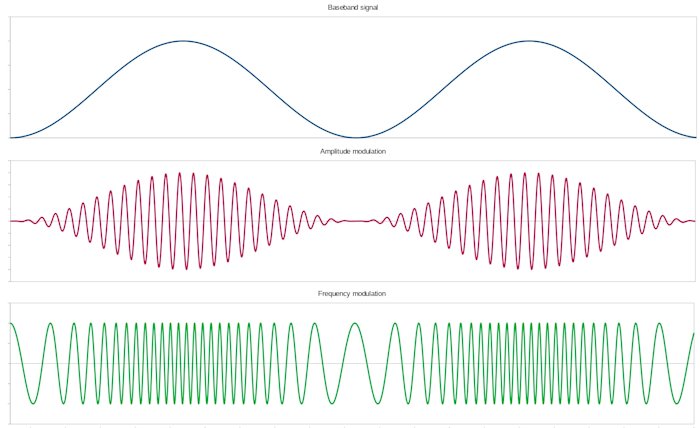
Representation of how an AM and FM signal encode the same base signal. Overvoltage, CC BY-SA 4.0, via Wikimedia Commons
Unlike AM, frequency modulated (FM) radio encodes audio by varying the transmission frequency whilst maintaining the amplitude. FM radio offers higher fidelity audio than AM as a higher bandwidth is allocated to each station. This allows more information per second to be sent, resulting in a higher resolution audio. FM also has the capacity to transmit audio in stereo, as opposed to AM’s mono. FM is less susceptible to interference as changes in amplitude can be ignored by the radio receiver. However, the shorter wavelengths used in FM radio are more easily reflected by structures and other physical obstacles, meaning FM transmissions have a smaller range than AM radio.
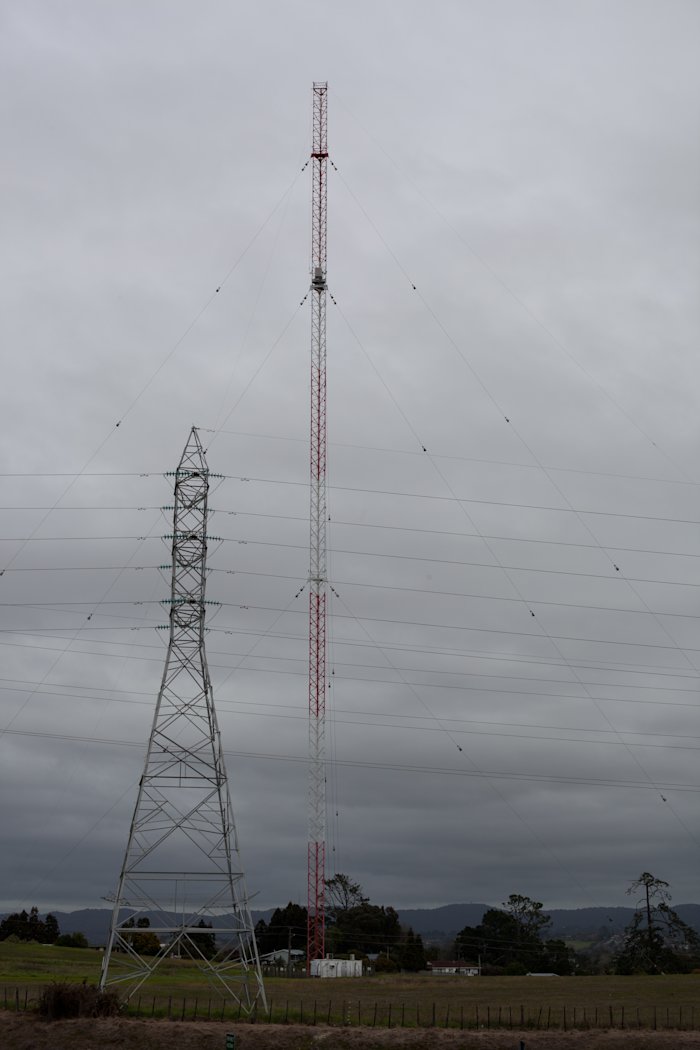
Radio New Zealand AM Transmission Mast, in Selwood Road, Henderson, Auckland. Image by russellstreet, June 19 2010 (https://www.flickr.com/photos/russellstreet/4900936168). CC BY-SA 2.0
As an example, the RNZ National AM station for Auckland broadcasts on 756 kHz (kilohertz), which corresponds to a wavelength of around 396 metres. The AM station is currently transmitted from a 152 metre tall mast at the northern end of Lincoln Road in Henderson, Auckland. The RNZ National FM station is broadcast on 101.4MHz (megahertz), which corresponds to a wavelength of around 2.95 metres. The FM transmitter is situated on top of the Sky Tower in Auckland’s CBD. The longer AM radio waves are able to bend around obstacles such as buildings and hills. The shorter FM radio waves will be reflected by such obstacles. The FM transmitter’s prominent location atop the Sky Tower allows for a wider coverage area.
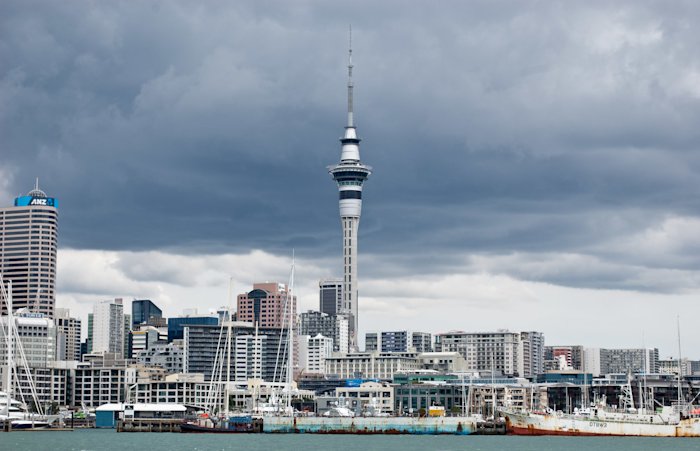
Image by Ben Williams, 06 February 2012 (https://www.flickr.com/photos/bodhack/7285414828). CC BY-NC.
Auckland's Sky Tower hosts the largest FM combiner in the world (most stations transmitted from one aerial). The transmission mast provides radio and television broadcasting, as well as other telecommunications services.
FM radio technology has existed almost as long as AM, an early narrow-band form was invented around 1919 by Hanso Idzerda in the Netherlands. FM was later developed into the current wide-band technology by Edwin Armstrong in the United States during the 1930s. FM radio broadcasting wasn’t widely used in New Zealand until the 1980s, despite FM’s decades-long history and the known benefits over AM. The New Zealand Broadcasting Corporation (NZBC) initially resisted permitting FM radio stations, asserting that high quality audio broadcasts were already available using tried and true AM technology. FM radio signals were first used by the NZBC during the 1960s as a carrier of TV audio transmission with the introduction of television in New Zealand.
One Double X – New Zealand’s first FM radio station
Radio Whakatāne, branded as One Double X after its callsign 1XX, was the first FM radio station to be licenced in New Zealand. A temporary FM station went on air during January 1982 broadcasting on 90.7MHz. Despite being licenced, 1XX had difficulties gaining consent from the NZBC for a permanent transmission location. Radio Whakatāne’s chief engineer Grahame Bryce originally requested to transmit from Manawahe, about 30km from Whakatāne, as the location offered favourable transmission and coverage qualities across the Rangitāiki Plains to Whakatāne. The NZBC declined this request due to the corporation’s preference to co-site television and radio FM transmitters, with a television FM transmitter nearby atop Pūtauaki (aka Mount Edgecumbe). The permanent FM station went live on 12 December 1988, transmitting on 90.5MHz from Pūtauaki. The station has since relocated to Manawahe, in 2017.
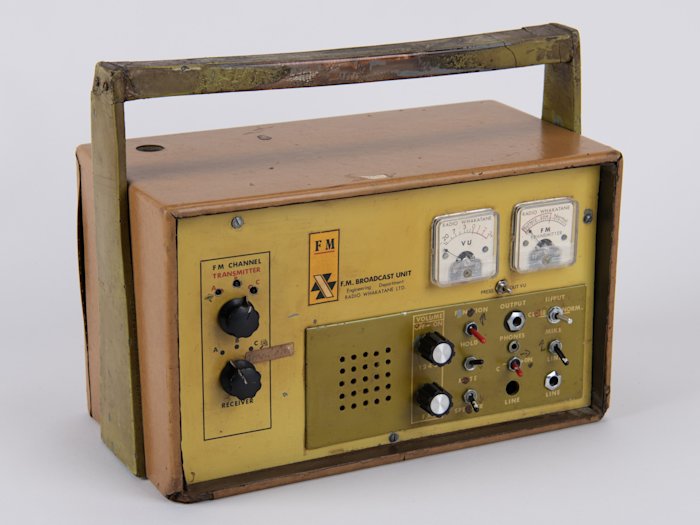
FM Broadcast Unit [2024.6] Museum of Transport and Technology (MOTAT)
This FM broadcast unit in MOTAT’s collection was designed and built by the Radio Whakatāne Engineering Department, namely Grahame Bryce and Kel Rimmer. It is unique in that it was constructed in the early to mid-1970s, well before the station’s switch to FM broadcasting. It is the first iteration of several units that were used in the field to conduct broadcasts, live interviews, and communicate with the station remotely.
This particular unit was known as the "lunch box" due to its compact and portable design. Its primary function was as an outside broadcast (OB) unit. Outside broadcasting refers to a broadcast occurring away from the main studio. The unit transmitted over the Very-High and Ultra-High-Frequency (VHF/UHF) B-Band of the radio spectrum. This provided a separate feed back to the studio that was off air to the broadcast listeners. The signal could then be relayed through the station's studio controls to go live to broadcast whilst being converted to AM transmission (prior to the station’s permanent switch to FM broadcasting in 1988). The use of a portable FM transmitter provided higher quality audio to be used in broadcasting and was much simpler than setting up a long wavelength AM antenna.
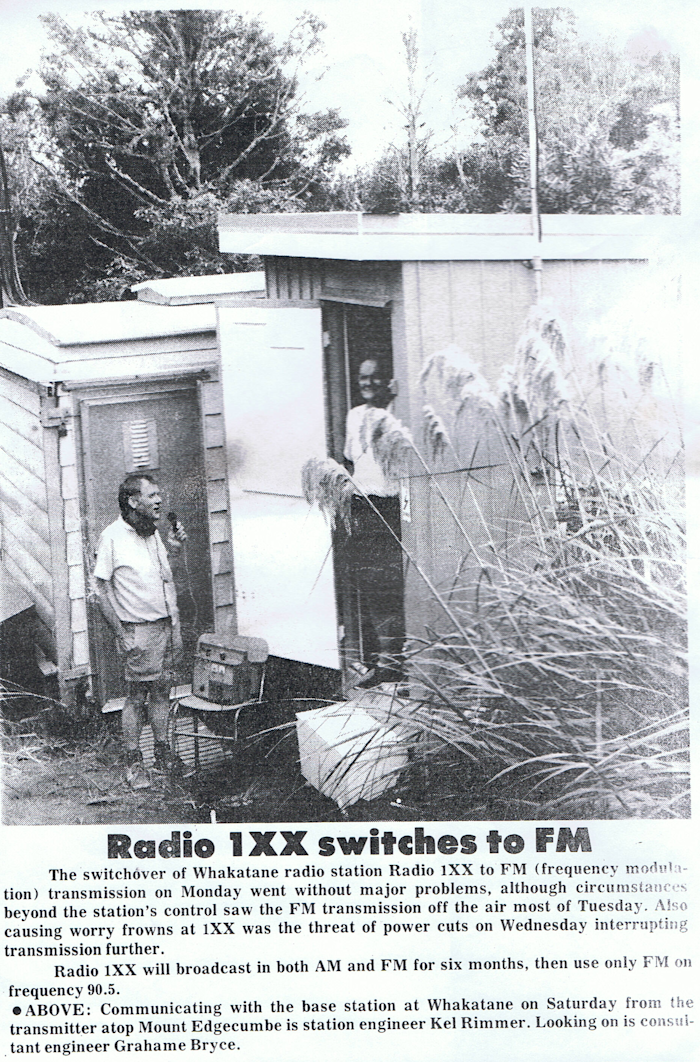
This article from the News Gazette (Kawerau), December 1988 shows 1XX engineer Kel Rimmer speaking through a microphone connected to an FM unit similar to the one in MOTAT’s collection. Courtesy of The Whakatāne Beacon, all rights reserved.
A major use of the unit was to enable live interviews with shop owners in downtown Whakatāne who had purchased five-minute advertising slots in the station's programming. Initially these interviews were done via a portable tape recorder, then transferred onto a tape cartridge back at the studio and edited before being broadcast, a process which took at least an hour. With the portable FM unit and its direct radio link to the 1XX studio, interviews could be broadcast live.
The unit originally had an antenna fitted to the top via a coaxial jack. This allowed line of sight transmission back to the 1XX building at 267 The Strand and offered a range of approximately 750m through the central business area of Whakatāne to the north-eastern end of The Strand. The signal could also be bounced off a translator station on Moutohorā (Whale) Island and then received back at the studio.
As well as being New Zealand’s first FM broadcaster, 1XX was the first provincial, independent, commercial radio station since the state monopoly over the radio broadcasting industry was broken in 1970 by Radio Hauraki. 1XX first went to air as an AM station broadcasting on 1240 kHz on 30 June 1971.

FM Broadcast Unit [2024.6] Museum of Transport and Technology (MOTAT)
Private radio in New Zealand
Private broadcasting had existed in the early days of radio in New Zealand. However, on-air advertising was prohibited making commercial opportunities unfeasible. During the late 1930s, the government began buying up the independent stations and by the start of the Second World War, all but two New Zealand radio stations were owned by the National Broadcasting Service (NBS) of the New Zealand Government. This effectively created a state monopoly over the industry. Gisborne’s 2XM continued to operate independently until it closed in 1963. Dunedin’s 4XD, being a non-commercial volunteer run station at the time, managed to survive. Now known as Radio Dunedin, the station was only commercialised in the 1990s and is now operated under the MediaWorks company. Founded in 1922, Radio Dunedin is the longest continuously broadcasting radio station in the country and in the British Commonwealth.
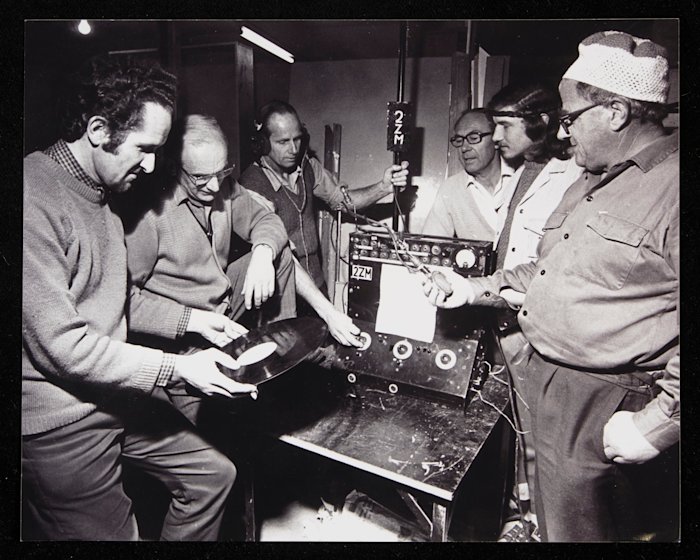
MOTAT communications section team members gathered around the 2ZM radio equipment previously used at MOTAT. Gisborne’s 2ZM radio station previously known as 2YM (1923-1926), and later as 2XM (1948-1963), was one of the earliest established stations in the country. Live Days: temporary radio station at MOTAT [04-215] Walsh Memorial Library, The Museum of Transport and Technology (MOTAT)
Radio Hauraki – New Zealand’s radio pirates
Perhaps New Zealand’s best-known example of a private radio station is Radio Hauraki. After the Second World War, growing dissatisfaction with the government’s offering of entertainment radio programming saw a renewed interest in private broadcasting. However, the NZBC (previously the NBS) persistently declined applications for private broadcasting licences and thus maintained its monopoly over the industry. This inspired the establishment of Radio Hauraki, which operated as an illegal pirate radio station broadcasting from international waters in the Hauraki Gulf / Tīkapa Moana. The pirate station first went on-air on 4 December 1966. The ensuing struggle between Radio Hauraki and the NZBC ultimately resulted in loosening of restrictions and so began the modern era of broadcasting in New Zealand. Radio Hauraki became New Zealand’s first licenced private commercial broadcaster of this new era, broadcasting legally from 26 September 1970.
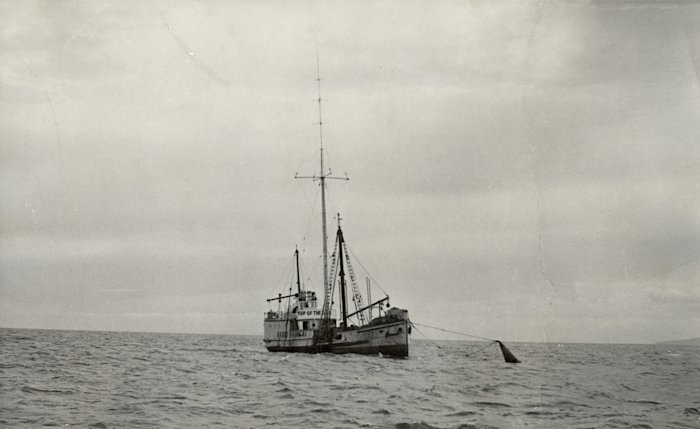
Radio Hauraki broadcasting offshore from the Tiri (ii) [12-4593] Walsh Memorial Library, Museum of Transport and Technology (MOTAT)
During their time at sea, Radio Hauraki operated onboard the ex-coastal traders Tiri, and subsequently Tiri (ii) after the first vessel was wrecked during a storm in 1968. The vessels were fitted out with all the necessary equipment to facilitate radio broadcasting. Tiri (ii), as seen in the image above, had a 140 foot tall lattice steel broadcast mast connected to an AM transmitter and studio equipment below deck.
The AM radio transmitter used was an ex-United States Navy Westinghouse TBL-13. This type of unit was used during the Second World War for transmitting morse code signals via low frequencies to submarines or high frequencies between ships. While it was a useful piece of equipment, Radio Hauraki’s chief engineer, Denis O’Callahan, extensively modified the transmitter to boost its power output and improve the clarity of transmissions. The TBL13 originally had a variable frequency oscillator, meaning the transmission frequency could be changed if the government tried jamming the signal. However, during refurbishments after the loss of Tiri (i), a 1480 kHz crystal oscillator made by local crystal manufacturer Rakon was installed to replace the variable oscillator as the risk of signal jamming was deemed to be low.
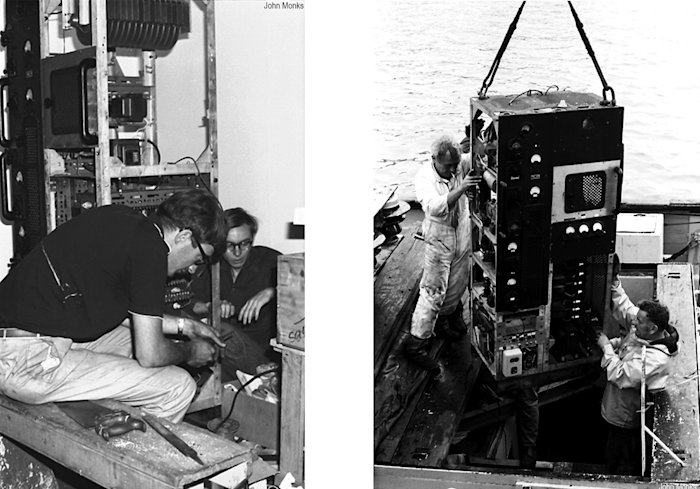
Left: Denis O’Callahan and John Tremaine refurbish the transmitter after salvage from Tiri (i) Right: Skippers Ivan Guard and Lloyd Griffiths guide the transmitter in/out of the hold of Tiri (ii) Images courtesy of John Monks, all rights reserved.
The transmitter served Radio Hauraki for the duration of the station’s time at sea and survived the wrecking of both Tiri (i) and Tiri (ii). When the station was finally granted a broadcasting licence and came ashore in 1970, the transmitter was retired and put into storage. A decade later it was rediscovered in a shed in Parnell and was donated to MOTAT in early 1982. The 1980s spelled a turbulent time for MOTAT and the whereabouts of the Radio Hauraki transmitter is now unknown, it is likely to have left the collection during this time.
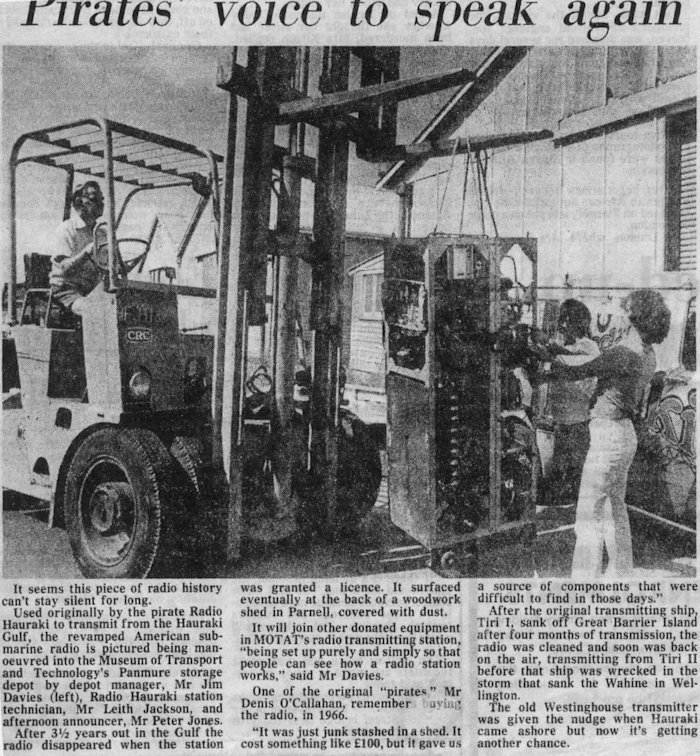
Radio Hauraki transmitter being unloaded at MOTAT’s previous storage site in Sylvia Park. Image from Eastern Courier, January 1982. Stuff Limited, all rights reserved.
The modern broadcasting era
The successes of Radio Hauraki paved the way for private commercial radio stations to enter the industry. Radio Hauraki was soon followed by Radio i (broadcasting from October 1970), Radio Waikato (late-1970/early-1971), and One Double X / Radio Whakatāne (June 1971). While the first three stations were metropolitan stations (Auckland and Hamilton based), One Double X claimed the spot of being the first provincial independent radio station in New Zealand, and subsequently became New Zealand’s first licenced FM broadcaster.
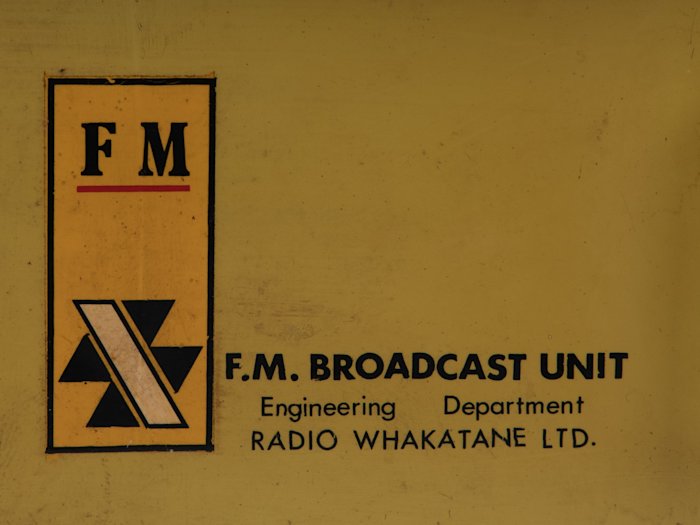
FM Broadcast Unit [2024.6] Museum of Transport and Technology (MOTAT)
Story by Callan Bird, Curator – Technology (MOTAT).
Story edited by Nicola Jennings, Senior Curator – Technology (MOTAT).
Published July 2024
Thank you to One Double X and Radio Hauraki personnel, past and present, for supplying imagery and information that made this article possible. In particular thanks to Brent Gilbert, Aaron Anderson, Chris Prouse, Denis O’Callahan, Craig Bain, Alan Wheatley, Colin Magee, Andy Galbraith, John Monks, Adrian Blackburn, and Steve Hilliar.
Sources
Anderson, A. (2022). Radio 1XX 50th Anniversary 1971-2021. Facebook. https://www.facebook.com/1XX50
Blackburn, A. (1988). The Shoestring Pirates (Second Edition). Hauraki Enterprises Limited, Auckland.
Blommerde. (2021, June 27). Radio 1XX, New Zealand's last private commercial radio station, celebrates 50 years. Stuff. https://www.stuff.co.nz/entertainment/125448250/radio-1xx-new-zealands-last-private-commercial-radio-station-celebrates-50-years
Broadcasting Tribunal. (1985, January 31). Decision No. 29/84. The New Zealand Gazette, (18), 415-418. https://www.nzlii.org/nz/other/nz_gazette/1985/18.pdf
Broadcasting Tribunal. (1988, March 31). Decision No. 3/88. The New Zealand Gazette, (56), 1349-1352. http://www.nzlii.org/nz/other/nz_gazette/1988/56.pdf
Furby, B.S. (1968, November 13). Advantages for NZ in FM broadcasting. Press, Volume CVIII, Issue 31835 Page 20. https://paperspast.natlib.govt.nz/newspapers/CHP19681113.2.174
Mishkind, B. (2021). New Zealand radio history. The Broadcast Archive. https://www.oldradio.com/archives/international/nzp.html
Monks, J. (2007). Radio Hauraki: The pirate years. Publishing Press Limited, North Shore City.
Netherlands Institute for Sound and Vision. (n.d.). PCGG Transmitter: Idzerda's transmitter technology (1919-1924). https://artsandculture.google.com/story/rAUBRpRPErXSIA
New Zealand Companies Office. (n.d.). Radio Bay of Plenty Limited (190026) removed. Companies Register. https://app.companiesoffice.govt.nz/companies/app/ui/pages/companies/190026
One Double X. (n.d.). NZ's last original private commercial radio station, to stay locally owned. Media Bay of Plenty Ltd. https://www.1xx.co.nz/post/nz-s-last-original-private-commercial-radio-station-to-stay-locally-owned
One Double X. (n.d.). The history of 1XX. Media Bay of Plenty Ltd. https://www.1xx.co.nz/about
Pauling, B. (2014, October 22). Radio. Te Ara - The Encyclopedia of New Zealand. https://teara.govt.nz/mi/radio/print
Radio 1XX News. (2022, June 30). Radio 1XX history series: The history of radio 1XX [Images attached]. Facebook. https://www.facebook.com/1XXNews/posts/radio-1xx-history-series-the-history-of-radio-1xxprior-to-the-establishment-of-1/5284169785000020
Radio 1XX News. (2023, December 12). Did you know... it's 35 years today that Radio 1XX has been on FM! [Images attached]. Facebook. https://www.facebook.com/1XXNews/posts/pfbid0huYMxknThCRq89EyrvNXJ6r98fTW4bhZGCkYuhkfrHWeqWXLiLhN3iWzxAj48WRfl
Radio Heritage Foundation. (2022, January 8). New Zealand MW & FM audio. Radio Heritage Foundation. https://www.radioheritage.com/new-zealand-mw-fm-audio
Radio Spectrum Management. (n.d.). Radiocommunications history in New Zealand. Ministry of Business, Innovation & Employment Hīkina Whakatutuki. https://www.rsm.govt.nz/assets/Uploads/documents/384b04ec58/radiocommunications-history-in-new-zealand.pdf
Radio Spectrum Management. (2024). Our history. Ministry of Business, Innovation & Employment Hīkina Whakatutuki. https://www.rsm.govt.nz/about/our-work/our-history
Sullivan, J. (1997). An Independent Air: The story of the Otago Radio Association and New Zealand’s oldest radio station – 4XD Dunedin. Otago Radio Association, Dunedin.